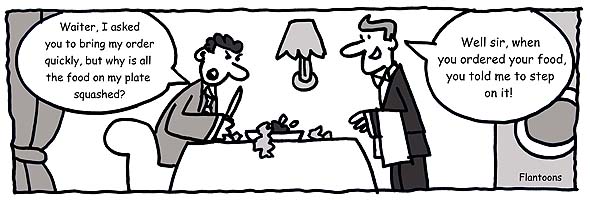Phrasal Verbs! Ways to learn and some examples + video!
 Understanding phrasal verbs can help you avoid situations like the cartoon above. Knowing them can make you sound more like a native speaker, and definitely help you understand native speakers, because they are incredibly common in everyday speech.
Understanding phrasal verbs can help you avoid situations like the cartoon above. Knowing them can make you sound more like a native speaker, and definitely help you understand native speakers, because they are incredibly common in everyday speech.
Phrasal verbs are idiomatic like expressions that have meanings separate from their literal verb meaning. They are also called two-word verbs because they are made up of a verb + a particle. There are also phrasal verb + preposition combinations, which would make three-word verbs. Let’s review some more information about phrasal verbs:
What’s the difference between a preposition and a particle?
Although they look the same, prepositions and particles are much different because one of them, particles, changes the meaning of the main verb it’s attached to. We’ll use the cartoon above as an example. The phrasal verb is: “step on it.” If we look at the words: ‘on’ and ‘it’ as prepositions, then there would be no change in the verb ‘step.’ So, “step on it” would mean to literally pick up your foot, and place your foot on whatever “it” is referring to. This is what the waiter in the cartoon did, because he obviously didn’t understand that the man meant “step on it” as a phrasal verb, which means to move/go quickly. As a phrasal verb the word “on” is not a preposition, but a particle, so remember it changes the meaning of the main verb “step.” I t no longer has the meaning “on top of.”
What’s the difference between transitive and intransitive?
Transitive verbs are verbs that take objects, so these phrasal verbs will always have an object (noun or pronoun) connected to it. Most of these verbs are separable, which means that you can put the object in between the main verb and particle. A couple of things to remember about this though:
1. If the object is a pronoun, it must go between the verb and particle (ex: look it up. Not:
look up it. *look up=try to find information in a book/online,etc).2. If the object is a long noun phrase, then it must go after the particle (ex: look up the cause for global warming nowadays. Not:
look the cause for global warming nowadays up.).
Intransitive verbs do NOT take objects, so neither will these phrasal verbs. With that said, they are inseparable.
How do you learn?
For a couple of tips watch my video!
Phrasal Verbs from the video context:
- To feel under the weather: (idiom) to not feel well, to feel sick
- show up- to arrive or appear somewhere
- call off- to cancel something
- get over- to overcome a problem, such as a sickness
- drink to- “cheers” to celebrate someone or something
- dress up- to wear formal clothing or special clothing for an event (ex: costume)
- whip up- to prepare food quickly
- head out- to begin a journey, to leave your house/place
- turn down- refuse, decline invitation
- cheer (someone) up- make someone happy who was not
Other phrasal verbs: show & call:
- show around- to act as a guide and point/show someone a new area or place
- show off- to boast or brag
- call for- to say something is needed; to go to a place and get something or someone
- call in- to make a telephone call to a place (or commonly:radio show); also to call work and not go because you’re sick. (ex:call in sick)
- call on- to choose someone to speak, ask someone to do something;
- call out- to shout, or speak in a loud voice, with a person to challenge them about what they said/did
- call up– to call someone on the phone
Remember the tips:
Learn through context, break them down by their main verb, answer questions, look up new words in a dictionary or phrasal verb book, write journals, and the most important thing… make them useful to YOU. Because phrasal verbs are a lot like vocabulary, you’ve got to find the best way for you to memorize. I always recommend making them personal, because then they are much easier to remember and use.
Don’t forget to answer the questions from the video in the comment section. Don’t remember? Watch again, practice listening comprehension, and write what you heard (then of course, answer)
Happy Studying! ♥
Like what you read? Please subscribe to the blog for more updates, and remember: knowledge is power and sharing is caring! Share the article with a friend to spread the love of English.
xoxo


[…] and/or review this grammar, such as focusing on themes, like love and chores, using listening and context, and the […]
[…] verbs is by focusing on some main verbs and building on the particles. No? Have a quick review here then… There’s even a video of […]
[…] verbs by transitive VS intransitive verbs, which is important to know, especially when reviewing phrasal verbs. Simply put, transitive verbs take objects and intransitive verbs don’t. Consider the easy […]
Very useful, as always
Thanks so much!!!